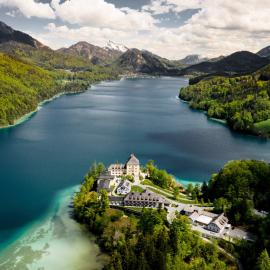
Hallein during Franz Xaver Gruber’s time
The world around Gruber, however, was anything but ideal at the time. Hallein was the province’s second biggest town back then with around 3,500 inhabitants. The salt trade, which had blossomed under the reign of Salzburg’s archbishops, had come to an end when the Habsburg Monarchy moved salt production to Hall in Tyrol, Aussee and Hallstatt. It was not just the salt workers that lost their employment, as the entire environment around salt production was negatively affected by changes in the labour market. Hallein’s coopers (barrel makers), for example, were left without work because the salt could now be transported in the more practical and also cheaper gunny sacks. Sailors were also suffering as a result of the decrease in goods to be transported (from originally 20,000 to barely 7,000 tons per year). The town’s linking to the railway system in 1871 meant that the time of shipping goods up and down the Salzach river had come to an end completely.
Those interested in the history of the Celts in Hallein, the Salzach river shipping industry and Salzburg’s archbishops, should pay a visit to the Keltenmuseum in Hallein. At the Dürrnberg plateau, you will also find the Hallein Salt Mine, the oldest exhibition mine in the world.
A life for music
Choirmaster Gruber was certainly anything but overwhelmed by money and funding during these economically troubling times. When it came to music, however, there was always a way for him. The trails between the villages and towns were long and cumbersome. There were few public stagecoaches and the journeys were expensive. From various letters, we know that Franz Xaver Gruber regularly walked the 13-kilometre-long journey to Salzburg or Maria Plain to attend musical events there. There is also proof that he received visits from his friend Joseph Mohr in Hallein: A day’s walk to Wagrain from Hallein was not a rare endeavour back then, or he would simply take the stagecoach. In 1841, Franz Xaver Gruber’s second wife Maria Breitfuß died. One year later, he got married to his third wife, who was also his second wife’s friend, the shoemaker’s widow Katharina Rieser (widowed Wimmer) from Böckstein.
Franz Xaver Gruber’s sons followed in their father’s musical footsteps. The oldest, Franz (*1826), founded a choral society in 1847 and the Halleiner Liedertafel musical group in 1849 which still exists to this day. The second son, Felix (*1840), emulated his father and became the choirmaster of Hallein. In Hallein, Franz Xaver Gruber published a document that clarified the question of authorship concerning “Silent Night” on 30 December 1854. Within it, he elaborated on the origins of the song’s lyrics and melody and cleared up false assumptions about the creation of the song, such as that it had originated from the Zillertal valley or that it had been composed by Michael Haydn.
Three of the four “Silent Night! Holy Night!” Autographs of Gruber are available and displayed in Hallein.
Franz Xaver Gruber died of old age in Hallein in 1863 as a respected and relatively affluent man.
On the traces of “Silent Night” in Hallein
- At Hallein’s parish church, you will find the excellent Silent Night Museum which reopened on 29 September 2018. It exhibits the history of the Christmas song, Joseph Mohr’s guitar and furniture pieces from Gruber’s former residence, as well as autographs and Franz Xaver Gruber’s official document explaining the origin and authorship of the song. Gruber himself lived in the sacristan house for 28 years.
- Review – Silent-Night-Museum in Hallein: Exhibition “Dem Komponisten begegnen” from 29 September – 03 February 2019
- During the Advent season, an actor assumed the role of Franz Xaver Gruber and invited visitors on entertaining strolls through the town.
- Right in front of the museum, visitors will find Gruber’s final resting place: Each year on 24 December at 17:00, the Halleiner Liedertafel musical group invites visitors to sing at Gruber’s tomb. Guests from all over the world accept the invitation and follow suit.
- On 25 November 2018, the new Silent Night Organ resounded in the parish church for the very first time.







